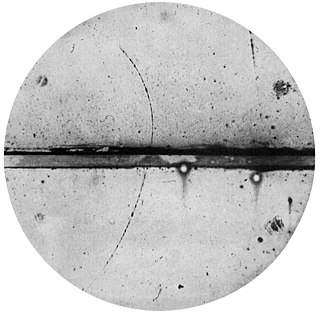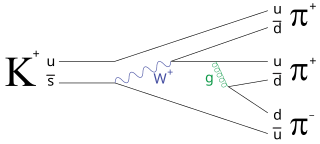
In modern physics, antimatter is defined as matter composed of the antiparticles of the corresponding particles in "ordinary" matter, and can be thought of as matter with reversed charge, parity, and time, known as CPT reversal. Antimatter occurs in natural processes like cosmic ray collisions and some types of radioactive decay, but only a tiny fraction of these have successfully been bound together in experiments to form antiatoms. Minuscule numbers of antiparticles can be generated at particle accelerators; however, total artificial production has been only a few nanograms. No macroscopic amount of antimatter has ever been assembled due to the extreme cost and difficulty of production and handling. Nonetheless, antimatter is an essential component of widely-available applications related to beta decay, such as positron emission tomography, radiation therapy, and industrial imaging.

In particle physics, a meson is a type of hadronic subatomic particle composed of an equal number of quarks and antiquarks, usually one of each, bound together by the strong interaction. Because mesons are composed of quark subparticles, they have a meaningful physical size, a diameter of roughly one femtometre (10−15 m), which is about 0.6 times the size of a proton or neutron. All mesons are unstable, with the longest-lived lasting for only a few tenths of a nanosecond. Heavier mesons decay to lighter mesons and ultimately to stable electrons, neutrinos and photons.

In particle physics, a pion is any of three subatomic particles:
π0
,
π+
, and
π−
. Each pion consists of a quark and an antiquark and is therefore a meson. Pions are the lightest mesons and, more generally, the lightest hadrons. They are unstable, with the charged pions
π+
and
π−
decaying after a mean lifetime of 26.033 nanoseconds, and the neutral pion
π0
decaying after a much shorter lifetime of 85 attoseconds. Charged pions most often decay into muons and muon neutrinos, while neutral pions generally decay into gamma rays.

In particle physics, a kaon, also called a K meson and denoted
K
, is any of a group of four mesons distinguished by a quantum number called strangeness. In the quark model they are understood to be bound states of a strange quark and an up or down antiquark.
In physical cosmology, baryogenesis is the physical process that is hypothesized to have taken place during the early universe to produce baryonic asymmetry, i.e. the imbalance of matter (baryons) and antimatter (antibaryons) in the observed universe.
The BaBar experiment, or simply BaBar, is an international collaboration of more than 500 physicists and engineers studying the subatomic world at energies of approximately ten times the rest mass of a proton (~10 GeV). Its design was motivated by the investigation of charge-parity violation. BaBar is located at the SLAC National Accelerator Laboratory, which is operated by Stanford University for the Department of Energy in California.

Jack Steinberger was a German-born American physicist noted for his work with neutrinos, the subatomic particles considered to be elementary constituents of matter. He was a recipient of the 1988 Nobel Prize in Physics, along with Leon M. Lederman and Melvin Schwartz, for the discovery of the muon neutrino. Through his career as an experimental particle physicist, he held positions at the University of California, Berkeley, Columbia University (1950–68), and the CERN (1968–86). He was also a recipient of the United States National Medal of Science in 1988, and the Matteucci Medal from the Italian Academy of Sciences in 1990.
In particle physics the semileptonic decay of a hadron is a decay caused by the weak force in which one lepton is produced in addition to one or more hadrons. An example for this can be

In physical cosmology, the baryon asymmetry problem, also known as the matter asymmetry problem or the matter–antimatter asymmetry problem, is the observed imbalance in baryonic matter and antibaryonic matter in the observable universe. Neither the standard model of particle physics nor the theory of general relativity provides a known explanation for why this should be so, and it is a natural assumption that the universe is neutral with all conserved charges. The Big Bang should have produced equal amounts of matter and antimatter. Since this does not seem to have been the case, it is likely some physical laws must have acted differently or did not exist for matter and antimatter. Several competing hypotheses exist to explain the imbalance of matter and antimatter that resulted in baryogenesis. However, there is as of yet no consensus theory to explain the phenomenon, which has been described as "one of the great mysteries in physics".

The Belle experiment was a particle physics experiment conducted by the Belle Collaboration, an international collaboration of more than 400 physicists and engineers, at the High Energy Accelerator Research Organisation (KEK) in Tsukuba, Ibaraki Prefecture, Japan. The experiment ran from 1999 to 2010.

Neutral B meson oscillations are one of the manifestations of the neutral particle oscillation, a fundamental prediction of the Standard Model of particle physics. It is the phenomenon of B mesons changing between their matter and antimatter forms before their decay. The
B
s meson can exist as either a bound state of a strange antiquark and a bottom quark, or a strange quark and bottom antiquark. The oscillations in the neutral B sector are analogous to the phenomena that produce long and short-lived neutral kaons.
In particle physics, B mesons are mesons composed of a bottom antiquark and either an up, down, strange or charm quark. The combination of a bottom antiquark and a top quark is not thought to be possible because of the top quark's short lifetime. The combination of a bottom antiquark and a bottom quark is not a B meson, but rather bottomonium, which is something else entirely.
The D mesons are the lightest particle containing charm quarks. They are often studied to gain knowledge on the weak interaction. The strange D mesons (Ds) were called "F mesons" prior to 1986.

In particle physics, CP violation is a violation of CP-symmetry : the combination of C-symmetry and P-symmetry. CP-symmetry states that the laws of physics should be the same if a particle is interchanged with its antiparticle (C-symmetry) while its spatial coordinates are inverted. The discovery of CP violation in 1964 in the decays of neutral kaons resulted in the Nobel Prize in Physics in 1980 for its discoverers James Cronin and Val Fitch.
OKA is a particle physics detector experiment at the U-70 accelerator in the Institute for High Energy Physics located in Protvino near Moscow (Russia). OKA is specialized experiment with separated charge kaons beam.

NA31 is a CERN experiment which was proposed in 1982 as a "Measurement of |η00 /η+-|2 by the CERN-Edinburgh-Mainz-Pisa-Siegen collaboration. It took data between 1986 and 1989, using a proton beam from the SPS through the K4 neutral beam-line. Its aim was to experimentally prove direct CP-violation.
Maria Fidecaro (1930-2023) was an Italian experimental physicist with a focus on particle physics. She has spent most of her career at CERN, where she after retirement had the status of honorary member of the personnel.
The Enhanced NeUtrino BEams from kaon Tagging or ENUBET is an ERC funded project that aims at producing an artificial neutrino beam in which the flavor, flux and energy of the produced neutrinos are known with unprecedented precision.

Bradley Cox is an American physicist, academic and researcher. He is a Professor of Physics and the founder of the High Energy Physics Group at the University of Virginia.














